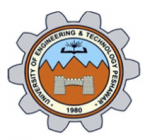ALGORITHM DEVELOPMENT AND IMPLEMENTATION FOR NUMERICAL DETECTION OF HOT SPOTS IN CASTING GEOMETRY
Fcroz Shah*~ Mohammad A. Irfan**, Rizwan Gul*~ Abdul Shakoor*
ABSTRACT
Numerical prediction of hot spots inside solid~fying castings is presented. Casting geometry is decomposed into rectangular sections. Arbitrary points are chosen in these sections from where vectors are generated which interact with surround- ing edges, comers, curved surfaces, holes etc. of the geometry. These vectors develop a network of triangular segments, which define the boundaries ofrectangular sections. MATLAB functions defined for rectangular sections decide the relative rectangular section for an arbitrary point. During implementation in MAT- LAB, 360 vectors are generated from an arbitrary point, through 1° to 360°. in a closed circle. Magnitude and direction of averaged values for all the vectors are computed for each iteration. The new point is moved relative to the previous point depending upon magnitude and direction of the average value of all the vectors. After few iterations the point converges inside the geometry which is recognized as the hot spot. This technique is sensitive to the itifluence of comers, cores, curved profile, fins, chills etc. Hot spots for several sections, i.e., L, 1; U. Stepped geometry and an engine saddle with and without holes were located. This technique shows good agreement to location of shrinkage cavity or porosity observed in cast sections.
To share on other social networks, click on any share button. What are these?




